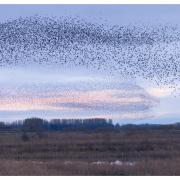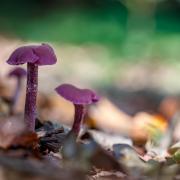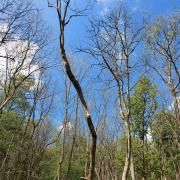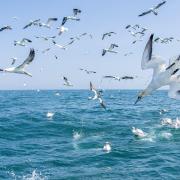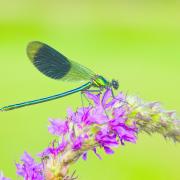The avocet is one of Yorkshire’s finest feathered residents but that wasn’t always the case, as Tom Marshall from the Yorkshire Nature Triangle reports

There are few birds that can truly earn the title ‘unmistakable’. Iconic, yes, in the case of the golden eagle or the inextricable link between Christmas and the robin, or indeed summer and the swallow. As familiar as these species are however, there’s still a chance they might just be mistaken for something else. When it comes to a double-take though, the avocet has no such problems.
While you may not know the name, there’s a pretty good chance you’ve seen the avocet’s distinctive up-curved bill adorning the work of the Royal Society for the Protection of Birds for generations, which today has led to the logo – and indeed the avocet – being one of the most recognised brands in the country.
It’s perhaps no surprise to learn that the avocet waded in to the nation’s consciousness and onto the RSPB’s logo after great early successes by the charity in bringing this elegant wader back from the brink during the 1940s and 1950s, alongside the recovery of many species championed following former persecution and the devastating impact of the late 19th century millenary trade.
Almost three-quarters of a century on, the avocet has certainly lived up to its status in the conservation limelight, and while its appearance on that famous logo has barely changed in all those decades, your chances of seeing one in the fully-feathered flesh are now rather better.

Those tentative early years – like so many stories of former British species making a comeback – saw the return of the avocet to habitats along the East Anglia coastline, just a short flight from strongholds in Europe.
As the 1950s became the latter part of the 20th century, sustainable populations soon began to build across Norfolk and Suffolk, while the Exe Estuary in Devon also became a popular winter haunt.
Although conservationists certainly had a strong hand in the creation of suitable des res for those pioneering first pairs of avocets along the East Anglia coast, the spread of these monochrome waders into new areas – including Yorkshire – was to come from an unexpected quarter.
As the avocet began to expand in numbers during the 1960s, so too did Britain’s construction and road industry, and vast gravel pit complexes were slowly developed along many of our major rivers as thousands of tonnes of sands and other aggregates were excavated to keep the country building.

Initially, the resulting giant holes left by the works simply filled naturally with rainwater and soon offered refuge for ducks, geese and swans, but limited interest for other wildlife. During the 1970s and 1980s however, groups like The Wildlife Trusts and the RSPB soon began to realise that these massive mud craters offered an amazing blank canvas of opportunity for creating new homes for nature.
Seizing on the chance, conservationists began to work in partnership with those behind the bulldozers to create natural habitats that had otherwise been lost through other changes in how we were managing our countryside elsewhere. Wetlands, vital reedbeds and pools with myriad small islands soon began to emerge from beneath the digger tracks along the UK’s natural river arteries. Fast-forward to the 21st century and today, former and operational gravel pits are now some of the most valuable and best-loved nature reserves across the country, and right here in Yorkshire.
Alongside birds like the little ringed plover, sand martin, bearded tit and bittern, the avocet has become a welcome beneficiary of this perhaps unlikely marriage between industry and conservation.
In the Yorkshire Nature Triangle, the avocet has now firmly taken up residence at sites including the RSPB’s Blacktoft Sands near Goole and at Yorkshire Wildlife Trust’s Kilnsea Wetlands near Spurn. It’s at Yorkshire Wildlife Trust’s North Cave Wetlands near Hull though where the transformation for avocets has been most remarkable.
Following 20 years of gravel extraction during the 1980s and 1990s, in 2000 the Trust, with support from local residents and Hull businessman Stephen Martin, set about creating the perfect habitat of shallow pools and islands for birds like the avocet – no mean feat when you’re presented with several very large, very deep holes.
Despite these challenges and with the backing of owners Humberside Aggregates, a stunning nature reserve began to emerge from the waters – and within a few short years avocets began to return too, perhaps for the first time in 250 years in an area known as Wallingfen along the Humberhead Levels.
With a long-term vision for more than 350 acres of pristine nature reserve, this summer, reserve manager Tony Martin thinks there could be over 40 pairs of avocets setting up home – making the site one of the most important on the Humber Estuary, and in northern England. Not a bad result for what used to be a hole in the ground.
With a boost from sites like North Cave Wetlands, avocet numbers across the UK have now recovered to an impressive 1,500 pairs and have become a firm feature of any spring and summer visit to Yorkshire – so why not take the chance to seek out this wonderful wader this month?
Amazing avocets
Avocets begin to arrive in their nesting areas during March and April, with the first fluffy chicks taking their tentative steps during May and June. Here’s where to see them.
YWT North Cave Wetlands, near Hull (HU15 2LY)
Multiple pairs of avocets nest here and can be viewed from the 2km nature trail and a number of fully accessible viewing hides and a new, covered picnic area.
RSPB Blacktoft Sands, near Goole (DN14 8HR)
Avocets are joined by bearded tits, bitterns and marsh harriers at this classic reedbed nature reserve with a number of viewing hides.
YWT Kilnsea Wetlands (HU12 0UD)
This relatively new nature reserve near Spurn is proving a hit with avocets and other wading birds in habitats created to replace those being lost to coastal erosion.
You can also try: YWT Potteric Carr near Doncaster, RSPB Fairburn Ings near Castleford, Lincolnshire Wildlife Trust Far Ings near Barton upon Humber.












